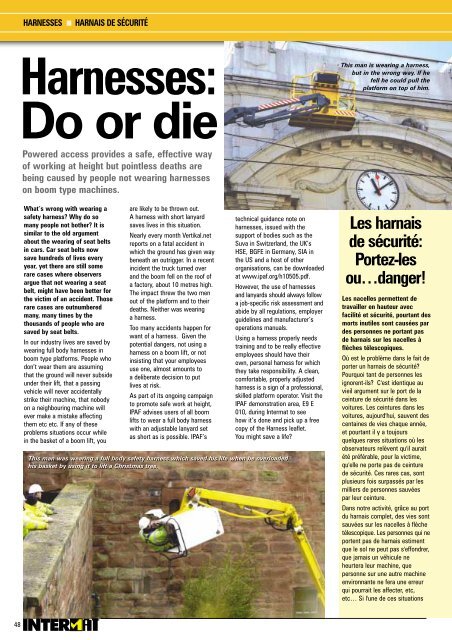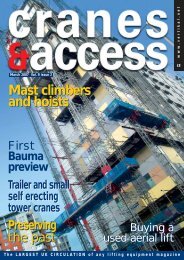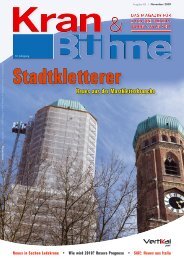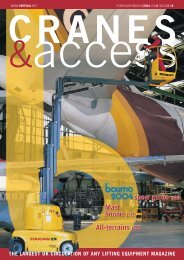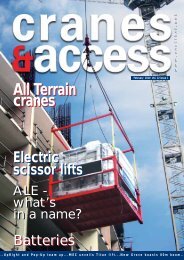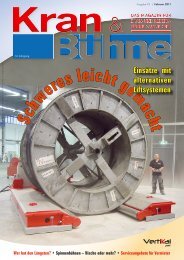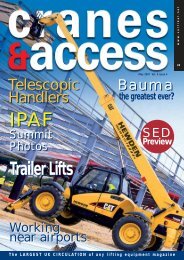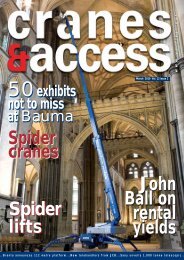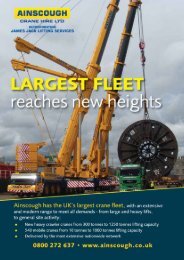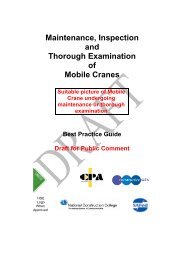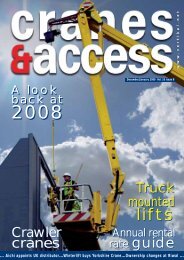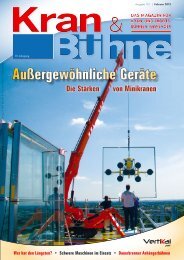specialist guide guide spécialisé branchenführer guide spécialisé
specialist guide guide spécialisé branchenführer guide spécialisé
specialist guide guide spécialisé branchenführer guide spécialisé
Create successful ePaper yourself
Turn your PDF publications into a flip-book with our unique Google optimized e-Paper software.
48<br />
HARNESSES � HARNAIS DE SÉCURITÉ<br />
Harnesses:<br />
Do or die<br />
Powered access provides a safe, effective way<br />
of working at height but pointless deaths are<br />
being caused by people not wearing harnesses<br />
on boom type machines.<br />
What’s wrong with wearing a<br />
safety harness? Why do so<br />
many people not bother? It is<br />
similar to the old argument<br />
about the wearing of seat belts<br />
in cars. Car seat belts now<br />
save hundreds of lives every<br />
year, yet there are still some<br />
rare cases where observers<br />
argue that not wearing a seat<br />
belt, might have been better for<br />
the victim of an accident. Those<br />
rare cases are outnumbered<br />
many, many times by the<br />
thousands of people who are<br />
saved by seat belts.<br />
In our industry lives are saved by<br />
wearing full body harnesses in<br />
boom type platforms. People who<br />
don’t wear them are assuming<br />
that the ground will never subside<br />
under their lift, that a passing<br />
vehicle will never accidentally<br />
strike their machine, that nobody<br />
on a neighbouring machine will<br />
ever make a mistake affecting<br />
them etc etc. If any of these<br />
problems situations occur while<br />
in the basket of a boom lift, you<br />
are likely to be thrown out.<br />
A harness with short lanyard<br />
saves lives in this situation.<br />
Nearly every month Vertikal.net<br />
reports on a fatal accident in<br />
which the ground has given way<br />
beneath an outrigger. In a recent<br />
incident the truck turned over<br />
and the boom fell on the roof of<br />
a factory, about 10 metres high.<br />
The impact threw the two men<br />
out of the platform and to their<br />
deaths. Neither was wearing<br />
a harness.<br />
Too many accidents happen for<br />
want of a harness. Given the<br />
potential dangers, not using a<br />
harness on a boom lift, or not<br />
insisting that your employees<br />
use one, almost amounts to<br />
a deliberate decision to put<br />
lives at risk.<br />
As part of its ongoing campaign<br />
to promote safe work at height,<br />
IPAF advises users of all boom<br />
lifts to wear a full body harness<br />
with an adjustable lanyard set<br />
as short as is possible. IPAF’s<br />
technical guidance note on<br />
harnesses, issued with the<br />
support of bodies such as the<br />
Suva in Switzerland, the UK’s<br />
HSE, BGFE in Germany, SIA in<br />
the US and a host of other<br />
organisations, can be downloaded<br />
at www.ipaf.org/h10505.pdf.<br />
However, the use of harnesses<br />
and lanyards should always follow<br />
a job-specific risk assessment and<br />
abide by all regulations, employer<br />
<strong>guide</strong>lines and manufacturer’s<br />
operations manuals.<br />
Using a harness properly needs<br />
training and to be really effective<br />
employees should have their<br />
own, personal harness for which<br />
they take responsibility. A clean,<br />
comfortable, properly adjusted<br />
harness is a sign of a professional,<br />
skilled platform operator. Visit the<br />
IPAF demonstration area, E9 E<br />
010, during Intermat to see<br />
how it’s done and pick up a free<br />
copy of the Harness leaflet.<br />
You might save a life?<br />
This man was wearing a full body safety harness which saved his life when he overloaded<br />
his basket by using it to lift a Christmas tree.<br />
This man is wearing a harness,<br />
but in the wrong way. If he<br />
fell he could pull the<br />
platform on top of him.<br />
Les harnais<br />
de sécurité:<br />
Portez-les<br />
ou…danger!<br />
Les nacelles permettent de<br />
travailler en hauteur avec<br />
facilité et sécurité, pourtant des<br />
morts inutiles sont causées par<br />
des personnes ne portant pas<br />
de harnais sur les nacelles à<br />
flèches télescopiques.<br />
Où est le problème dans le fait de<br />
porter un harnais de sécurité?<br />
Pourquoi tant de personnes les<br />
ignorent-ils? C'est identique au<br />
vieil argument sur le port de la<br />
ceinture de sécurité dans les<br />
voitures. Les ceintures dans les<br />
voitures, aujourd'hui, sauvent des<br />
centaines de vies chaque année,<br />
et pourtant il y a toujours<br />
quelques rares situations où les<br />
observateurs relèvent qu'il aurait<br />
été préférable, pour la victime,<br />
qu'elle ne porte pas de ceinture<br />
de sécurité. Ces rares cas, sont<br />
plusieurs fois surpassés par les<br />
milliers de personnes sauvées<br />
par leur ceinture.<br />
Dans notre activité, grâce au port<br />
du harnais complet, des vies sont<br />
sauvées sur les nacelles à flèche<br />
télescopique. Les personnes qui ne<br />
portent pas de harnais estiment<br />
que le sol ne peut pas s'effondrer,<br />
que jamais un véhicule ne<br />
heurtera leur machine, que<br />
personne sur une autre machine<br />
environnante ne fera une erreur<br />
qui pourrait les affecter, etc,<br />
etc… Si l'une de ces situations


